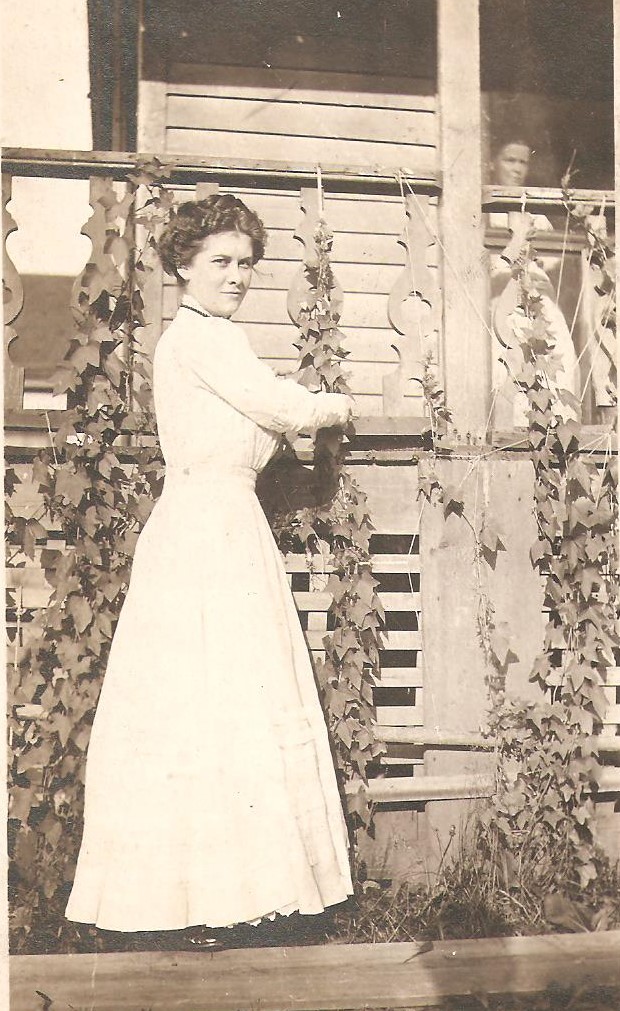Harriet Mae Foxton (1887 – 1985)
Written by her niece Sheila Copley
It was six-year old Mae’s first day of school in 1893, and she was eager to do everything the teacher asked. She sat quietly on the bench looking shyly at the other students around her. When the teacher told the class to pick up their slate, Mae automatically used her right hand and with her left, she held her pencil poised ready to hear what he was going to tell them to do next. She was after all, left-handed, just like her mother. The teacher took one quick look at her hands and with a scowl on his face, took a few long-legged strides until he was standing in front of her. Before she could blink, he smacked her knuckles sharply with his pointer, Mae cried out in pain and dropped her pencil. “Put the pencil in your right hand!” he spoke sternly. With tears in her eyes and her head down, she picked up the pencil with her right hand. From that moment on, Mae did her very best to remember to use her right hand in school.
She learned at an early age, being left-handed was frowned upon by some people. Her own paternal grandparents believed there was “something wrong” with people who were left- handed. Her grandmother was always correcting her, telling her to use her right hand when eating or picking up her glass. She couldn’t understand why but tried not to create any tension between her mother and her grandparents. Her grandparents were Irish but Mae wasn’t sure if that had anything to do with it or not. She was always on pins and needles when they visited.
When Mae finished school, she was sent to live for a year with an elderly woman in poor health. After the woman passed away, Mae returned home and worked in a candy store where she learned how to dip chocolates.
Her mother made arrangements for her to move to Ann Arbor in Michigan to live with her aunt. Mae thought she was lucky to obtain a position as a seamstress in a store called ‘Modesty’ but when her mother heard where she was working, she insisted Mae quit her job immediately. Her mother thought she might become a victim of white slavery. Next, Mae worked for three years as a maid for a University Professor doing housework and helping care for the couple’s two children. She started courting a young fellow and they were soon engaged. He gave her a beautiful diamond ring but before they could marry WWI broke out and he enlisted. Several months later she learned he had been killed. Mae was devastated!
Her mother and younger brother Benjamin, moved to Ann Arbor in 1910 while her father and older brother travelled to southern Alberta to take up a homestead. The three of them found a small house to rent. They all worked and saved as much money as they could. When her father wrote telling them to sell everything and come west, she was excited to travel to this newly formed part of Canada to see what it was like. After a long three-day journey, they stepped off the train on a hot, windy day only to be immediately surrounded by mosquitoes. As the wagon drew closer to their new home, Mae and her mother were uneasy to see how isolated they were and even more disheartened when they saw the crude structure her father and older brother had built for them to live in, but 16-year old Ben thought it was all a great adventure! A month later she climbed back onboard the train, heading east for Ann Arbor. It hadn’t taken her long to realize there was no future for her in such an Isolated area of Alberta. Mae only had enough money to buy a ticket to Winnipeg where she disembarked. Her father’s younger sister, Elizabeth had married and moved as a new bride to the town where her husband had found work as a school teacher. Mae knew she could stay with them until she had earned enough to buy a train ticket back to Michigan.
She worked at the Eaton’s store until after Christmas when once again, she climbed back onto the train and headed east, back to a life she felt more comfortable in.
Mae never married, she had numerous jobs; working in a photographer’s store, at a dry- cleaning establishment and as a bookkeeper in a furniture store. When a friend involved in real estate suggested she buy an empty lot she made the purchase and within a few months, was able to sell it making a modest profit. With the money Mae earned, she purchased a large house at the advice of her friend. In an university town, students were always looking for a room to rent. She made a few renovations, and the home was ready. At first, she continued working but found she wasn’t home to show the rooms when the students dropped by. She decided to quit her job and focus on her rooming house venture.
Mae did very well with this enterprise and owned several houses, each a little newer with more rooms to rent until she was 77 years of age. At that point she decided she wanted to be closer to her two brothers who were both living in Burnaby. She sold her rooming house and most of her furniture and moved west. She bought a small one-bedroom house which sold a few years later to a contractor looking for property to build an apartment building. Living in Burnaby was a big change from Ann Arbor but finally she was living close to her brothers whom she hadn’t seen for many years.
Mae died at the age of 97 still living independently, in her own apartment.